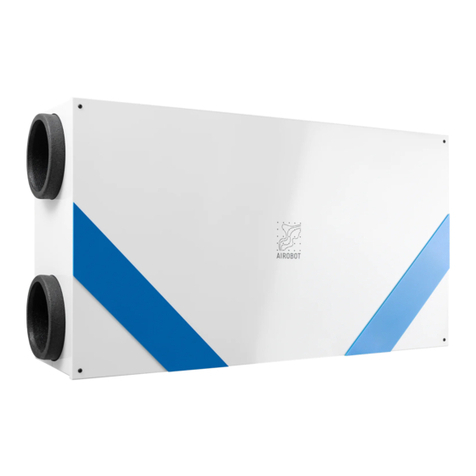
7
Boost mode
In boost mode, temporarily switches the setting to maximum speed (10), and after a while switches the device back to the
previous (automatic or manual) mode. The duration of the mode depends on the choice made during activation: from 30
minutes to 6 hours
Overpressure mode (fireplace mode)
The overpressure mode creates a temporary overpressure in the room by reducing the exhaust fan speed relative to the supply
fan and switching back to the previous (automatic or manual) mode after a certain time. The duration of the mode depends on
the choice made during activation: from 30 minutes to 6 hours. The operating speed depends on the setting, which can only be
set in the mobile application "Settings - Overpressure mode air flow rate".
Air quality and sensors in the device
Carbon dioxide (CO2) sensor
Indoor air quality is assessed primarily on the basis of the level of carbon dioxide or CO2. In living quarters, the main sources of
CO2 are the person himself and the burning of gas (gas stove) or wood (fireplace, oven). It is about 4% in the air exhaled by a
person, 0.03-0.04% in the ambient air, so there is about 100 times more of it in the indoor air than in the outdoor air.
Various studies also confirm that it is CO2 that is most often a reflection of human well-being. It depends on how well you sleep,
how rested you are when you wake up in the morning, how energetic you feel and how busy you are during the day. The high
amount of CO2 in the surrounding air makes it difficult to concentrate and work, due to which work performance decreases. In
addition, the concentration of CO2 is associated with the spread of viruses - a high level of CO2 suggests that this is a poorly
ventilated room, and in this room there are a lot of particles exhaled by people.
The amount of CO2 in the air is expressed as a unit denoted by ppm (parts per million). That is, how many particles of the test
substance are in the considered unit of space per million particles. The level of CO2 in the air can be estimated and measured
as follows: the starting value is considered to be 400, which is the concentration of CO2 in clean ambient air, green or good is
between 400 and 800 ppm; yellow or average between 1000 and 1600 ppm, red or bad if it is more than 1600 ppm and this is
the limit from which air quality has a negative impact on a person.
Principle of operation: Airobot ventilation units measure the level of CO2 through the exhaust pipe - the sensor is located
inside the device. Thus, the averaged value of all rooms reaches the device by a few - the larger the size of the ventilated room,
the more inaccurate the value shown by the device may be relative to a particular room. The biggest advantage of an in-device
CO2 sensor is that the device has the ability to assess the presence in the premises in cooperation with other sensors.
Airobot's unique on-premises detection feature is one that can reduce your device's power consumption (especially during
winter periods) by ~30% (compared to conventional ventilation equipment, the exact energy saving rate depends on the actual
use and varies).
When working in the automatic mode of the ventilation unit, the user can choose a suitable CO2 limit, above which the
ventilation rate is increased. Depending on the season, it may be necessary to adjust this limit, as the CO2 sensor constantly
calibrates itself.
CO2 and air quality scale considering Airobot ventilation unit
*The air obot ventilation unit analyzes the exhaust air so the scale may vary depending on the size of the ventilated rooms, the
calibration of the sensor and the season.
Automatic calibration: All CO2 sensors (including the Airobot sensor) need constant re-calibration. Re-calibration of easy-to-
use CO2 sensors is carried out automatically and does not require user intervention. The automatic self-calibration algorithm
assumes that the sensor is exposed at least once a week to a clean air CO2 concentration of 400 ppm, which is considered to
be clean ambient air. In the case of rooms, it is assumed that at least once a week the rooms should be completely empty for
half a day, so that the CO2 concentration can go close to the outside air, and then the sensor can use it as a new starting
value. Thus, for example, during summer periods, when windows are often kept open, the CO2 sensor reading may be
completely different from that of the winter period, since the rooms have a persistently low concentration of CO2 and the
sensitivity of the sensor has changed. Sometimes, rarely, the sensor calibration can also go out of place, in which case a new
calibration of the sensor can be done manually by contacting the helpdesk.





























